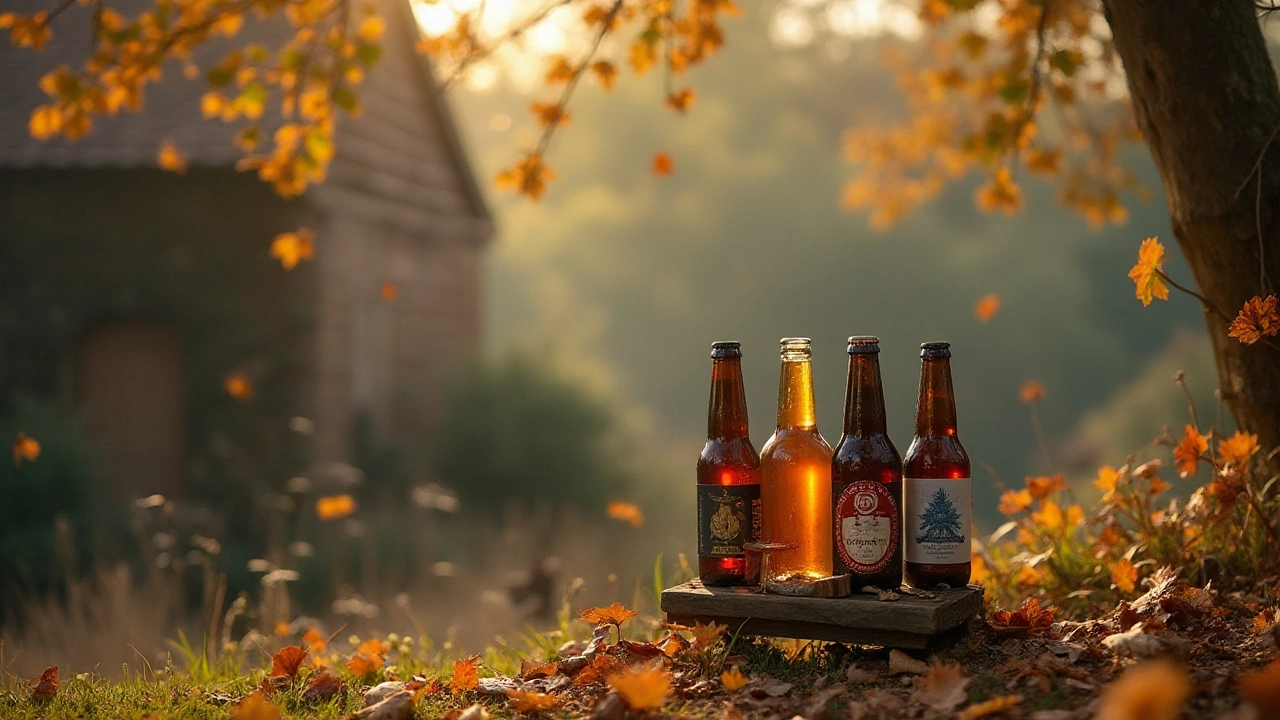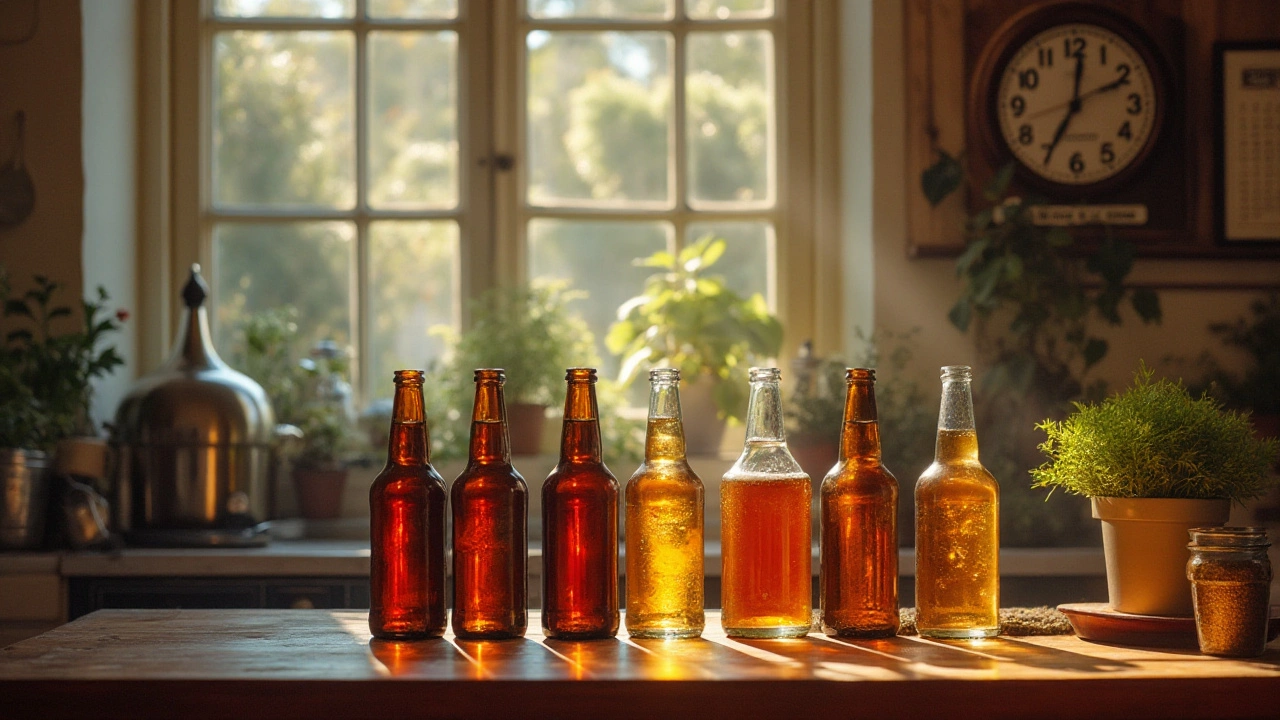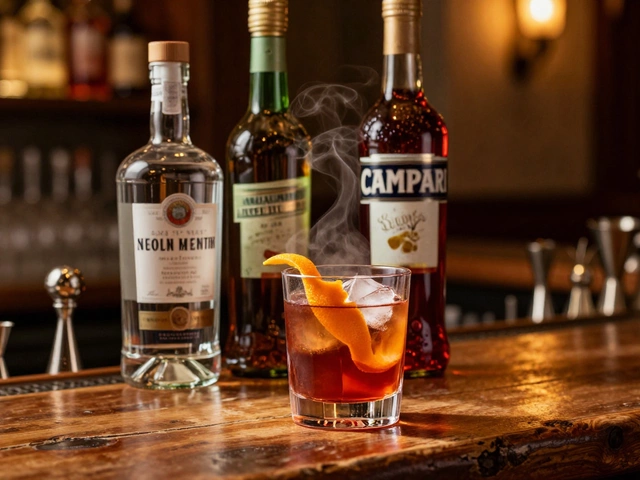Creating your own homebrew is a journey filled with anticipation and creativity. But once you’ve carefully bottled your brews, when is it the perfect time to crack one open and truly enjoy your handiwork?
Knowing exactly how long to wait after bottling can make all the difference in achieving the ideal flavor and carbonation. Different styles of beer and individual brewing techniques can offer a range of maturation times. Whether you're a seasoned brewer or a curious newcomer, understanding these nuances will help ensure your brew is a memorable experience.
Join me as we explore the art of beer maturation, dissecting every step to deliver the ideal time to savor your homebrew. You’ll discover some in-depth insights and simple tricks that turn waiting into an art form all its own.
- The Science Behind Maturation
- Recommended Waiting Times
- Factors Affecting Maturation
- Common Mistakes in Homebrew Maturation
- Tips for Optimal Flavor
- Advanced Techniques for Homebrewers
The Science Behind Maturation
The moment you seal your brew in a bottle, a chemical symphony begins its play beneath the cap. This is where the art of maturation and the science of beer come together to craft the perfect sip. Inside each bottle, a complex interaction happens as yeast continues its slow, deliberate dance, munching away at residual sugars. This process not only perfects carbonation but also profoundly influences the flavors and aromas that homebrewers relish. A critical factor during this phase is the type of yeast used. Different yeast strains can affect the rate and outcome of maturation, dictating how long you might need to wait. For instance, ales and lagers each have unique yeasts that require different maturation times.
Temperature plays another pivotal role. Fermentation and maturation temperatures are crucial for determining how the flavors evolve. For instance, a common recommendation is to maintain a consistent 60-68°F for ales and a cooler 45-55°F for lagers during this period. At the right temperatures, the various esters and phenols developed by the yeast can be either accentuated or mellowed, significantly modifying your brew’s flavor profile. A fact worth noting is how oxidation can sneak into the process; this is the enemy of homebrewers everywhere, subtly affecting the taste of the beer if not carefully controlled by limiting air exposure.
"Beer is proof that God loves us and wants us to be happy." - This quote attributed to Benjamin Franklin humorously underscores humanity’s enduring fascination with crafting the perfect beer.
With an understanding of these scientific aspects, you can see why patience is a key ingredient in homebrewing. Unlike the instant gratification of commercial products, homebrew often demands faithful waiting to reach perfection. Each passing day, week, or even month helps transform the flavors and carbonation to their intended state. One practical trick for homebrewers is to test batches at specified intervals, allowing for a more personal gauge of how maturation affects flavor over time. The delicate balance achieved in the bottle—combining the right yeast, temperatures, and waiting periods—is essential to producing a beautifully matured homebrew. So the next time you reach for a bottle, remember: there's more than just liquid inside; it's a glimpse into the science and craft dedicated to every drop.
Recommended Waiting Times
After the rewarding process of bottling your homebrew, the next step involves an equally important phase—waiting. Patience is not merely a virtue in this stage; it's an essential part of the homebrewing journey. As you anticipate that first satisfying sip, you might wonder: How long is the perfect wait? The timeline largely depends on the style of beer you’ve lovingly crafted as well as the specific ingredients and techniques you've employed.
Ales, commonly brewed by home enthusiasts, typically require a waiting period of about two to four weeks. During this time, carbonation develops, and the flavors meld gracefully. However, an additional one to two months can further enhance their character. If you've brewed a pale ale, enjoy it relatively young for its fresh hop characters. Meanwhile, more robust ales like IPAs may reach their peak after a month as their bitter profiles mellow out and stabilize.
Lagers, contrastingly, are naturally more patient spirits. They traditionally require a more extended maturation period, often between six to eight weeks, due to their cooler fermentation temperatures and slower yeast activity. This time ensures clarity and clean flavors that the style is cherished for. It's worth noting that lagers could benefit immensely from even more extended storage if you can resist temptation.
Homebrewer and beer enthusiast Charlie Papazian famously stated,
"Relax. Don't Worry. Have a Homebrew."His words encapsulate the experience perfectly. Maturation time is indeed subjective, and while guidelines exist, taste preference remains the ultimate judge. Even in the case of stouts and porters, which boast complexity due to roasted malts, some aficionados might mature them over several months to a year to reach that harmonious equilibrium.
Now, let's not overlook the homebrew spirits that push the boundaries—sours and high-alcohol brews. These need much longer periods to settle. Sours can be left to age anywhere from a few months to years, achieving depth and sophistication that raw science can't quantify. But remember, with bigger ales above 8% ABV, patience must match their strength. Allow at least six months, if not longer, for these to balance out adequately. A homebrew IPA that received a full-year maturation? That's a fervent nod to dedicated brewing bliss right there.
Embedded in this waiting game is the cycle of tasting. Never shy away from occasionally sampling your beer, albeit in moderation, to experience its transformation over time. Document your impressions—nothing serves better as a learning tool than firsthand experience paired with good notes. Who knows, you might develop a personal timeline tailored to your practices, unlocking the ideal moment to enjoy each cherished bottle.

Factors Affecting Maturation
The maturation phase of your homebrew is akin to a coming-of-age story. During this period, your beer's flavors develop and mature, transforming into a finely crafted beverage. Several elements influence this process, each adding its own unique twist to the tale. Temperature plays a crucial role; maintaining a consistent cool environment can enhance a beer’s maturation, often resulting in a smoother and fuller flavor profile when you finally uncork that bottle. Too warm, and you might accelerate the maturation at the expense of subtle flavors. Brewers typically find that keeping bottles at temperatures between 55 and 65 degrees Fahrenheit works best.
Yeast presence is another fascinating aspect many might overlook in homebrewing. The little powerhouses left in the bottle post-fermentation continue to operate, cleaning up flavors considered undesirable at the beginning stages. Over time, yeast can reduce off-flavors and enhance the complexity of the beer maturation. However, it's important to remember that dead yeast can introduce unwanted flavors if the beer is aged too long. Think of the yeast as one of your most important brewing allies and give it the respect it deserves by monitoring maturation closely.
While discussing these factors, it is important to consider the specific style of beer you're brewing. Different styles require different maturation times and conditions. An IPA might be ready in as little as a few weeks, whereas a stout or a barleywine could take months to reach optimal taste. Style-specific ingredients such as hops and malts also interact during maturation, modifying the beer's final flavor. Some styles, like lambics, thrive with a longer maturation time as it allows their sour characteristics to settle beautifully.
Impact of Oxygen Exposure and Light
Oxygen, often considered an enemy in brewing circles, can significantly affect your brew's maturation phase. When bottles are improperly sealed, oxygen can sneak in, leading to a process known as oxidation. This often imparts stale and papery flavors, an unfortunate addition to your carefully crafted concoction. Using oxygen-scavenging caps, or storing in a pressurized environment, can be beneficial.
"Oxygen is the dagger at your beer's back," noted renowned brewer Charlie Papazian. "Minimize its influence, and you protect your beer's soul."Light exposure is another villain in the maturation narrative, particularly with beers that are particularly hop-forward. Ultraviolet rays can degrade the aromatic hop compounds, leading to a skunky aroma that haunts many a poorly-stored six-pack. Dark bottles help, but storing your brews away from direct light sources is even more critical for ensuring your heavenly homebrew isn’t compromised.
Lastly, a table might be handy for visual learners exploring this intricate dance of influences:
| Factor | Impact on Maturation |
|---|---|
| Temperature | Consistency enriches flavor, too warm can spoil. |
| Yeast | Improves flavors over time; needs monitoring. |
| Oxygen | Oxidation harms taste, keep exposure low. |
| Light | Can cause spoilage, store in the dark. |
Common Mistakes in Homebrew Maturation
Embarking on the journey of homebrewing is an adventure laced with both creativity and science. However, seasoned brewers and novices alike often stumble on the common pitfalls associated with the maturation phase after bottling. One major mistake is misjudging the temperature at which the brew is stored. Temperature fluctuations can drastically alter the carbonation level of your homebrew, potentially ruining the delicate balance you've worked so hard to achieve. A stable temperature, usually between 65-75°F (18-24°C), maintains the beer's integrity, promoting optimal yeast activity and flavor development.
Another frequent error is inadequate patience. The excitement of tasting your creation can lead to premature sampling. Drinking the beer too soon after bottling often results in a flat, unrefined taste as the beer hasn't had enough time to carbonate and mature. Most homebrews require at least two weeks for proper maturation, but certain styles like lagers or stronger ales might take weeks longer to fully develop their flavors. Observation and careful tasting at intervals can guide you in determining the right time to enjoy your brew.
Oxygen exposure is another silent enemy in the maturation stage. Even a small amount of oxygen can lead to oxidation, resulting in off-flavors like cardboard or a stale taste. Ensuring a proper seal during bottling and using oxygen-absorbing caps can mitigate this risk. Many homebrewers find themselves with disappointing results because they overlook the importance of a good seal. A tip shared in
“The Brewer’s Companion” emphasizes, 'Never underestimate the quiet power of tight-capped bottles; they can spell the difference between a great and a mediocre brew.'
It’s also crucial to avoid excessive sediment as it can taint your beer with unwanted cloudiness and off-flavors. This happens when yeast and other particles from the wort are inadvertently bottled, impacting the brew's clarity and taste. Employing meticulous siphoning techniques during bottling ensures a cleaner beer. Filtering your brew or conducting a cold crash before bottling can substantially reduce sediment presence, granting your beer a crisp, clear appearance that complements its well-developed taste.
Rushing through the cleaning process of your brewing kits is another common mistake with potentially dire consequences. Any remnant of residue or unclean equipment can introduce bacteria that spoil the entire batch. Investing time in cleaning and sanitizing your equipment pays off in spades, ensuring your homebrew remains pristine during maturation. Leveraging sturdy cleaning brushes and effective sanitizers is an unsung hero among successful brewers.
Finally, neglecting to monitor bottle pressure is a mistake that can lead to explosive results. As the yeast ferments the sugar that generates carbonation, too much pressure can build up if not checked periodically. Over-carbonation can lead to exploding bottles, posing safety hazards. Using a hydrometer to monitor the fermentation process and selecting the appropriate amount of priming sugar before bottling can help maintain the ideal pressure level, allowing your beer maturation to proceed smoothly and safely.

Tips for Optimal Flavor
Achieving the optimal flavor in your homebrew is a harmonious blend of art and science. The process extends beyond the initial brewing and bottling stages, requiring an understanding of factors that can influence the eventual taste of your beer. It all starts with selecting the right ingredients. Be picky about your malt, hops, and yeast. These not only form the backbone of any homebrew but also greatly impact the taste profile. Many seasoned homebrewers suggest experimenting with different hop varieties to introduce nuanced flavors and aromas. A significant factor affecting beer flavor lies in the fermentation process. Temperature control is critical; too high or too low of a temperature can dramatically skew the taste. Keep your brew within the recommended range for the specific yeast strain you're using, ensuring a balanced and desired outcome.
After fermentation, aging plays an indispensable role. Some brews, like lagers and stronger ales, benefit from more extended aging periods. Think of it like a fine wine aging; complexities develop, and smoother flavors emerge. Many budding brewers misjudge and open their bottles too soon, robbing themselves of these enhancements. Incorporate taste tests over time post-bottling; track how flavors evolve. A study shared in the 'Journal of Brewing and Distilling' noted that many flavors become more rounded and less aggressive with proper aging. Storage condition is another vital contributor. Keep your bottles in a dark, cool place to prevent unwanted light or heat exposure, which can spoil the beer. Regularly check on them, ensuring a stable temperature. A pro-tip: label your batches with dates and notes in order to better track their transformation over time.
Adding adjuncts or extras like fruit, spices, or herbs can also create interesting twist on flavors. Infusions should usually be done during secondary fermentation to avoid overwhelming the primary character of your brew. Experiment with small batches before committing to larger ones, protecting against potential disappointments. Some combinations are timeless, while others may surprise. Don’t hesitate to seek inspiration from traditional brewing recipes, or adapt them with your creative spin. In a 2023 survey by Homebrew Magazine, brewers who experimented with new ingredients reported a 30% increase in satisfaction with their end product. Develop a refinement process for your preferred flavors.
"Brewing is not just about the recipe; it's about the journey of creation. Each tweak and taste test teaches you more about your craft,” says renowned brewmaster John Palmer.
Monitoring and Adjustments
Finally, keep monitoring and be ready to adjust throughout various stages. Ingredient substitutions, different brewing equipment, or varying water qualities can bring unexpected changes to the flavor. Keep detailed notes at each step. Regularly taste test your brew over different intervals to comprehend how its flavor matures. Remember, brewing is equal parts patience and passion, and excellence often comes through practice and experience. As you delve deeper into homebrewing, savor each moment and each sip.
Advanced Techniques for Homebrewers
Dabbling in homebrewing invites a world of experimentation, and as you hone your skills, embracing advanced techniques can elevate your creations. Advanced homebrewers often explore methods that tease out even more vivid flavors and aromas. One such technique involves aging your brew on wood chips. Infusing your beer with various wood, such as oak or cherry, can impart sophisticated layers. Each type of wood offers distinct notes, unveiling subtleties well beyond standard hops and malt combinations. Wood aging is not just about flavor; it interacts with the chemical compounds in your beer, bringing forth undertones that might previously remain hidden.
Another distinct and advanced step is the secondary fermentation process. This technique can be likened to a musician practicing post mastering their craft—fine-tuning those final nuances. In secondary fermentation, the beer is transferred to another container, allowing for sediment separation and clarity improvement. Some brewers deploy dry hopping at this stage, which plunges fresh hops into the fermenter for amplified aroma and zest. It's the trick to those lush, aromatic brews that pop with every sip. Although it adds time, secondary fermentation can be well worth the wait, letting beers mature naturally without muddied flavors.
"Patience is never more a virtue than when practiced by a brewer," said the venerable brewmaster John Palmer in his classic text, a testament to meticulous craft routines that prioritize time and care.
Temperature control also stands out as a game-changing aspect of advanced brewing. Maintaining consistent fermentation temperatures can dramatically influence your brew's profile. Erratic changes can lead to unwanted esters or off-flavors. Investing in a temperature-controlled fermenter allows brewers to experiment and control different profiles, whether they're aiming for a crisp lager or a rich stout. Homebrew temperature management doesn't have to stop at fermentation, either. Cold crashing—a process where the homebrew is rapidly dropped to near-freezing temperatures—encourages any suspended particles to settle quickly, resulting in brilliantly clear beer.
Exploring seasonal ingredients is another exciting frontier for enthusiastic homebrewers. Each season offers a cornucopia of fresh produce, from winter spices to summer berries, that can transform a standard beer into a seasonal celebration. Consider adding ingredients like orange peel in the winter months or fresh raspberries come summer. Not only does this amplify the beer's complexity, but it also supports local produce, ensuring every pint tells a story both rooted in nature and personal craft.
Advancing in homebrewing also implies experimenting with intricate yeast strains. Many new strains have been bred specifically for homebrewers, offering unique fermentation characteristics. Technologies today allow you to tailor the taste and aroma through yeast choice, whether you're looking to emphasize fruitiness, earthiness, or a clean lager finish. Comprehending yeast behavior and meticulously handling them sets apart casual enthusiasts from seasoned artisans. For those seeking more control, the homebrew yeast starter kits are an excellent step.
To put all these techniques into context, a study examined 100 homebrewing efforts, revealing an 83% acceptance rate for beers utilizing advanced practices in competitions or commercial consideration. Whether through statistics or personal anecdotes, stories of creative triumphs set the brewers apart, lending a profound appreciation for the mastery behind each pint.


